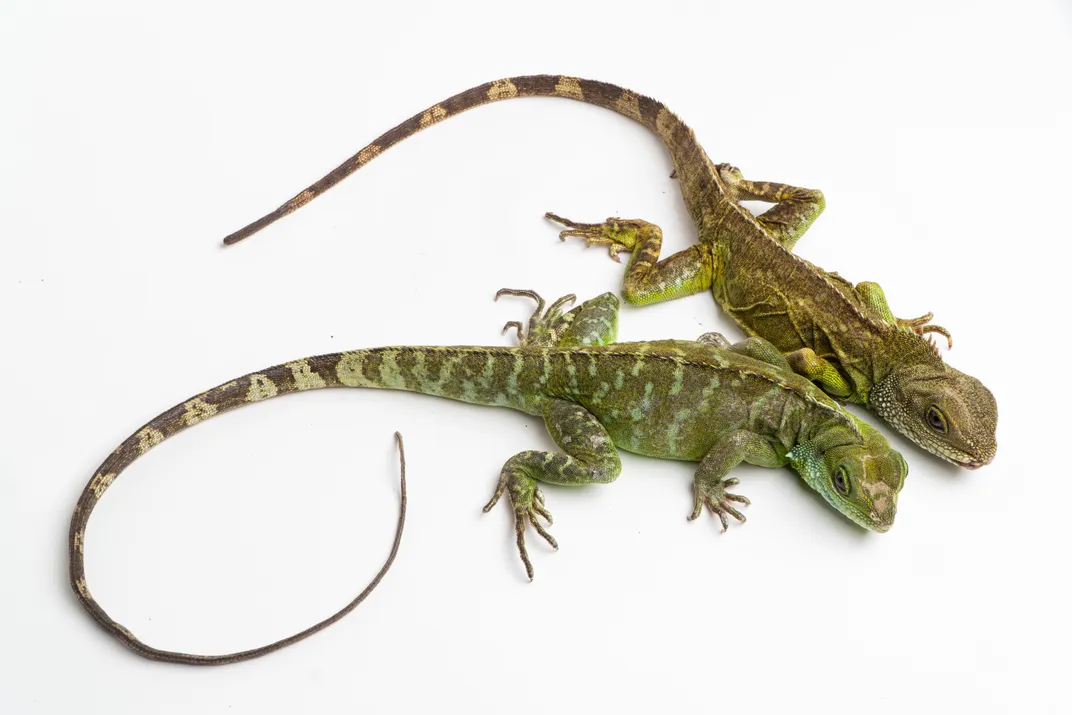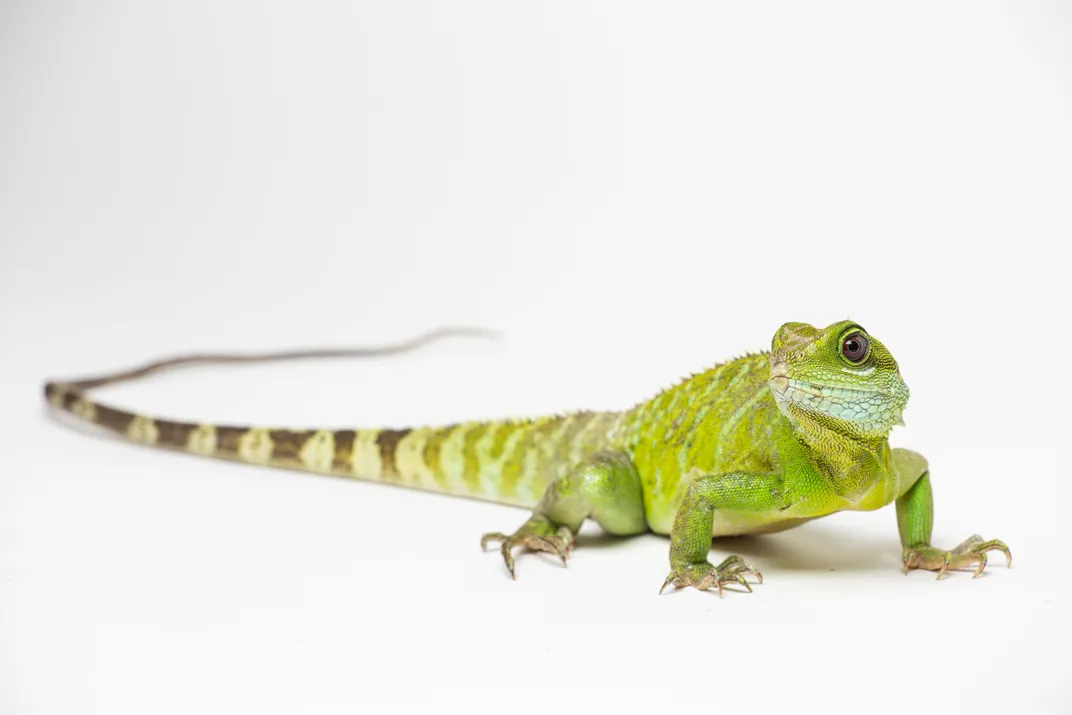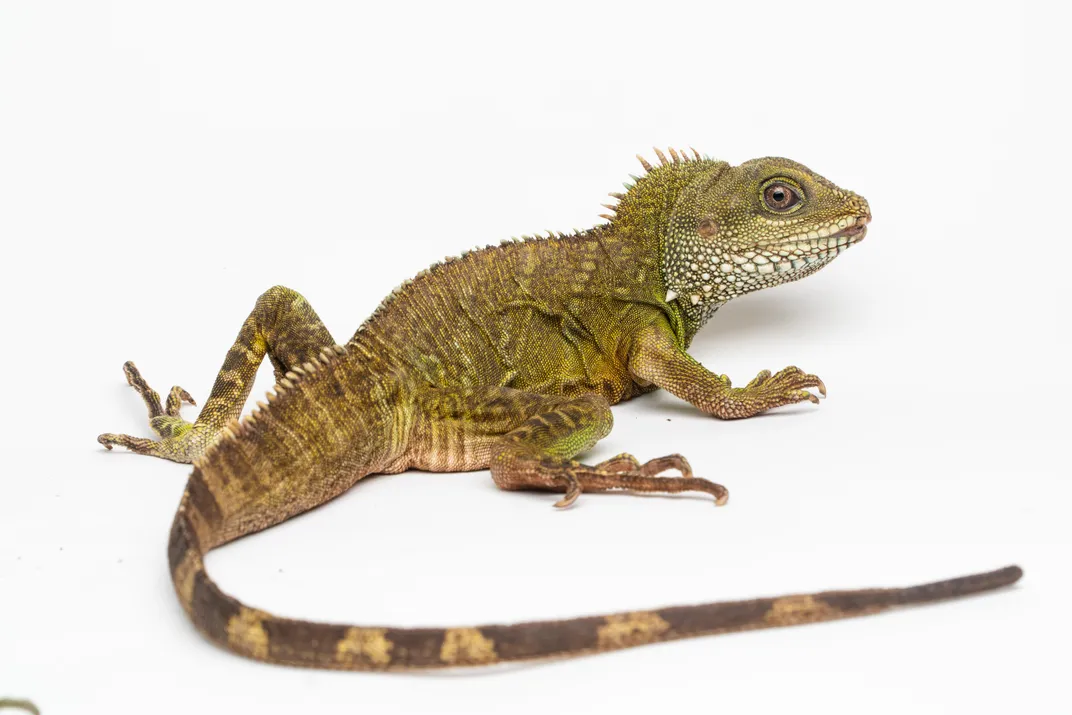The National Zoo’s Female Asian Water Dragon Successfully Reproduced Without a Male
This is the first time facultative parthenogenesis has been recorded in both the species and the reptilian Agamidae family
/https://tf-cmsv2-smithsonianmag-media.s3.amazonaws.com/filer/0d/d7/0dd731ff-fd55-4d62-8b8c-7adf288385ee/20181114-skipbrown020.jpg)
Asian water dragons typically live to be 10 to 15 years old, so the death comes as a shock. This lizard in particular has been closely studied since she was born and researchers hoped to study her further when she reached breeding age, which for her species is around three years old. Her mother, who is 13 years old, is still alive and healthy.
A female Asian water dragon housed at the Smithsonian’s National Zoo has successfully produced healthy offspring without the assistance of a breeding male. As researchers led by Kyle Miller, an animal keeper at the Zoo’s Reptile Discovery Center, report in the journal PLoS ONE, the unusual occurrence—officially known as facultative parthenogenesis—marks the first time this behavior has been recorded in both the Physignathus cocincinus species and the reptilian Agamidae family.
In layman’s terms, parthenogenesis refers to female reproduction conducted without any genetic contribution from a male. According to Science Direct, obligate parthenogenesis happens when organisms can only reproduce asexually, while facultative parthenogenesis takes place when species capable of sexual reproduction resort to solo methods. Although the latter variation occurs most commonly among isolated captive specimens, recent research has shown that it is also seen in wild populations.
To date, animals including pythons, bonnethead sharks, Komodo dragons and even birds have been known to practice parthenogenesis. As Heather Bateman, a conservation biologist at Arizona State University who was not involved in the research, tells Smithsonian.com, the reproductive method is common among certain reptile families; in Arizona alone, six out of 12 known whiptail lizard species are parthenogenic.
Speaking with Smithsonian.com, Anuradha Batabyal, a graduate researcher at the Indian Institute of Science’s Centre for Ecological Sciences who was also not involved in the study, says that studying parthenogenesis is key to “understanding the evolutionary significance of sexual and asexual reproduction and how and why some species have retained both reproductive modes.”
It’s possible, Batabyal adds, that parthenogenesis could provide a chance for species to thrive in harsh environmental conditions, “as every female has the potential to start a new population.”
WD-10, the bright green lizard at the center of the study, has resided at the zoo since November 2006, according to a press release. Born at the St. Louis Zoo four months prior to her arrival in Washington, D.C., the specimen was originally expected to act as an animal ambassador rather than a breeding female. But in 2009, the water dragon began producing eggs despite never coming into contact with a male member of her species. These eggs, believed to be unfertilized, were regularly discarded until 2015, when keepers started incubating them for a research project focused on reptile fertility.
Surprisingly, incubation revealed that the lizard’s eggs were actually fertile. According to the study, a clutch of seven eggs laid in November 2015 failed to produce living offspring but yielded two fully developed hatchlings that died in their shells. The next set offered more promising results: Although the majority of the eggs failed to reach the final stages of development, one female was successfully hatched in June 2016. A second healthy hatchling followed in November 2018 but later died of gastrointestinal tract blockage after ingesting a larger object than it could properly digest.
In an interview with Smithsonian.com, study co-author Robert Fleischer, head of the Smithsonian Conservation Biology Institute’s Center for Conservation Genomics, explains that Zoo staff considered two main explanations for the water dragon’s egg production: “Is the female producing these fertile eggs on her own, without any help or input from a male, or [was] she inseminated many years before?”
In the latter scenario, the female would have stored sperm from a previous mating—perhaps occurring prior to her arrival at the zoo—until it was needed to fertilize eggs. This behavior, while not out of the question, was viewed as “highly unlikely” given the reptile’s prolonged isolation from males.
To assess whether the female was actually practicing parthenogenesis, Fleischer and his colleagues extracted a DNA sample and sequenced a portion of the animal’s genome. At first, the researchers set out to compare this genome with DNA markers from the Australian water dragon, but after learning that the two species were only distantly related, they instead opted to develop their own set of genetic markers.
According to the study, the team focused on 14 microsatellite primer pairs, or tracts of repeated DNA. Six of these pairs contained two alleles, or gene variants, carried by the water dragon. This older female, in turn, received one of the alleles from her mother and the other from her father.
Analysis showed that WD-10’s offspring had inherited just one allele rather than the two typically produced by the fusion of egg and sperm. This sole allele matched one of the two carried by the mother—an expected result given the fact that offspring would have received one, not both, of its mother’s alleles.

Miller, the study’s lead author, tells Smithsonian.com that the team believes the reproductive event was triggered by WD-10's isolation from other members of her species, particularly males.
As the study explains, at least 47 percent of the 64 eggs recovered from WD-10 were fertile, but only two hatched into healthy offspring. Given this low rate of success, the researchers theorize that the water dragon may have simply experienced accidental parthenogenesis. It’s possible, however, that factors such as imperfect incubation conditions could be behind the eggs’ stunted development.
If the water dragon did in fact undergo accidental parthenogenesis, Earyn Nycole McGee, a PhD candidate at the University of Arizona who was not involved in the study, says that she would be interested in the sex of the offspring from these eggs and whether there may be an inherent pattern.
“I wonder if it would cause the sex ratio to favor males so that females could mate sexually in the future,” McGee explains to Smithsonian.com.
Moving forward, the researchers plan on monitoring the sole surviving offspring to see whether she, like her mother, lays any fertilized eggs. As Miller notes, zoo staff will incubate any eggs laid by either the mother or her daughter. Although there are currently no plans to bring in a male water dragon to assess how it interacts with the females, the option remains in play.
If both mother and daughter successfully undergo parthenogenesis, Miller says it will “almost be as if they have the ability to create multiple generations via parthenogenesis, and this wasn't just an accidental one-off kind of thing.”
Speaking with Smithsonian.com, Miller concludes, “Somewhere in their evolutionary history, they [could] have this trait where they can repopulate ... completely in the absence of mates.”
Rachael Lallensack contributed reporting to this article.
/https://tf-cmsv2-smithsonianmag-media.s3.amazonaws.com/accounts/headshot/mellon.png)




/https://tf-cmsv2-smithsonianmag-media.s3.amazonaws.com/accounts/headshot/mellon.png)